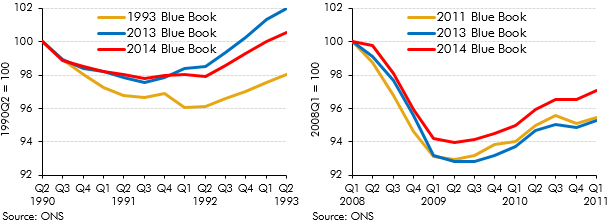Revisions to National Accounts data are a normal part of the Blue Book process, which reconciles the different measures of GDP and incorporates information from annual data sources. The 2014 Blue Book contained particularly large changes because it was the first time that the National Accounts were published on an ESA10 accounting basis. This box set out some of the key changes in Blue Book 2014 and their impact on some of the key economy variables.
This box is based on ONS GDP data from October 2014 .
The economic data underpinning this report are consistent with the latest Blue Book, to be published on 31 October. In addition to the regular annual updates to a number of data sources (such as full-year tax data) and rebasing the figures (now to 2011), the ONS has also aligned the National Accounts to the latest international guidance, as set out in the European System of Accounts 2010 (ESA10), and taken on board a number of other methodological changes.
Spending on research and development (R&D) and some military equipment is now classified as investment (which contributes to GDP) rather than intermediate consumption (which does not). These changes have raised the level of GDP, but have not greatly affected its profile.
Consistent with ESA10, the treatment of pension liabilities has also changed. These largely affect particular sectors in equal and offsetting ways, so have little effect on GDP overall. Household pension saving is now determined by the promised pension benefits from pension schemes, rather than the actual contributions paid into the scheme. This raises the measured saving ratio as households’ incomes are notionally higher, but consumption is unaffected.
Methodological changes unrelated to ESA10 have also generally raised GDP and have affected its path over time. These include: the inclusion of illegal activities; updates to the data and compilation process for estimating investment, inventories and imputed rent; using a new source for data on non-profit institutions serving households (NPISH); and changing the way financial intermediation services indirectly measured (FISIM) and spending on new cars are measured.
In total, the changes have raised nominal GDP by around 4 per cent in recent years. The average real growth rate has been revised down by 0.1 percentage points on average each year from 1998 to 2007 and up by 0.4 percentage points on average each year from 2008 to 2013.
Charts A and B show the impact of revisions to Blue Book data on the path of real GDP during the recessions that started in 1990 and 2008 respectively. Between 1993 and 2013, the net effect of revisions to the estimated path of GDP over the three years following the pre-recession peak in the second quarter of 1990 was to make the earlier recession shorter, shallower and followed by a stronger economic recovery. This year’s Blue Book revisions have had a similar impact on the path of the more recent recession and recovery since 2008. Ironically, this year’s Blue Book revisions have also delayed and slowed the estimated recovery in the early 1990s. But the latest data still suggest that the earlier recession was only half as deep as initial estimates suggested and that all of the loss of GDP had been recouped by the second quarter of 1993, while the National Accounts published at the time suggested that only half had been.
Chart A: The changing profile of the 1990s recession and recovery (left) and Chart B: The changing profile of the latest recession and recovery (right)

